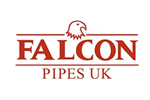

There was a time when if you saw an Englishman smoking a pipe, you could bet with nearly 100% certainty that it was a Falcon.
American engineer Kenly Bugg, from Fort Wayne, Indiana, invents the Falcon pipe by combining metal parts made of aluminum and a bowl made from heath wood. He bases the system on the principle that causes rain to fall from a cloud when it meets cold air. To achieve this effect, Bugg uses aluminum because it is a very lightweight material and, more importantly, because it ensures rapid heat dissipation. The pipe’s bowl, made from heath wood, is designed with a screw thread of four turns at its base so that it can screw onto the rest of the aluminum stem, forming a small trap to collect moisture. This ensures that all the moisture created during smoking is trapped, leaving the smoke to pass through the aluminum stem, cool as it swirls along the walls of the stem, and reach the smoker’s mouth as dry and cool as possible, providing the ultimate enjoyment.
The first sales of the Falcon pipe in the USA. Unfortunately, sales are limited by the need to maintain strategic materials for World War II. Only a limited production is possible, and most of the production is distributed through “Service” stores, established to supply the American Armed Forces.
Mr. George Hunt of Diversey Machine Co. in Chicago takes over the manufacturing and marketing of the Falcon pipe, initially in Indiana, Michigan, Illinois, and Iowa. Production quickly increases after the restrictions imposed for World War II are lifted. Due to a prolonged legal battle over patent rights, production rights for Falcon pipes were not secured until 1956.
6 million Falcon pipes are sold in the United States alone.
Diversey Machine Works moves to 4117N Kilpatrick Avenue, Chicago.
England. Mr. David Morris, President and CEO of the well-known British group “Multiple Tobacconists A. Lewis (Westminster) Ltd,” attends the Wembley Cup Final, where he notices someone smoking a Falcon pipe. Impressed, he arranges an early meeting with Mr. Hunt in Chicago. It is agreed to set up a trial marketing venture for the UK market. Indeed, 10,000 Falcon pipes are imported and distributed through around 350 branches of A. Lewis (Westminster). The success is immediate, and Mr. Morris is convinced of the potential of this remarkable pipe. He then creates two new companies: “Falcon Pipes Ltd” and “Falcon Pipes Distributors Ltd.” Afterward, he begins negotiations for the manufacture of Falcon pipes in England. It takes him over two years to perfect all the complex equipment required for production and to secure the supply of large quantities of the finest heath wood to produce the necessary bowls.
In May of that year the first 30,000 pipes were ready for distribution in the United Kingdom and after a moderate consumer advertising in the press, they sold quickly. Thus a change was made towards the traditional and conservative pipe smokers and which amounted to a smoking revolution. Gradually Mr. Morris, faced with the astonishing success of the Falcon pipe, gave up other business interests in order to concentrate fully on the further development of the Falcon pipe.
As consumer interest remains strong, a new small factory appears in Shepherds Bush, London, producing around 10,000 Falcon stems weekly. This early English production is licensed, and Mr. Morris now successfully negotiates the global distribution rights for the Falcon pipe, except for North America, where “Falcon International Incorporated” in Chicago continues its operations.
Further expansion in the UK becomes necessary, and in February, the company moves to larger facilities in Brentford, with a weekly capacity of production around 20.000 pcs of Falcon stems.
The launch of Alco Pipe by Falcon.
The name Alco came about when Falcon began its first distribution in the UK. George Hunt, realizing that the traditional pipe manufacturer Comoy had a series in their collection with the same name, decided to change the name to avoid any confusion. The decision was made to alter the already produced stems by removing the first and last letters of the word Falcon (F and N) because the thickness of the aluminum allowed it to be done. In no case could the entire name be removed without destroying the stem. Eventually, as the trademark issue was settled and it was proven there were no issues with Comoy, the name Falcon continued to exist in the UK, and the name Alco was retained only for another series of Falcon pipes, the smaller-sized ones.
The launch of the “THE PIPE” series by Falcon. Completely new materials were used to create these pipes, but the series ultimately proved unpopular among pipe smokers.
The launch of the “Brendford Pipe” by Falcon. This pipe was withdrawn from the market in 1979.
Falcon International Incorporated, in Chicago, USA, steps away from American production, leaving supply needs to be met by The Falcon Pipe Group Ltd in Brentford, Middlesex, England.
Falcon introduces a completely new concept in pipe smoking, the Falcon International filter pipe, with a detachable mouthpiece for optional use of a 6mm filter.
After the success of the Falcon International filter pipe, Falcon launches the Alco Universal filter pipe, a stem designed to attract younger pipe smokers, and for the first time introduces a new mouthpiece with ridges-bites, suitable for all pipe smokers.
Falcon’s Hat Trick… the introduction of the following to the market:
Falcon is purchased by Merton Limited, now known as Merton & Falcon Ltd.
Merton & Falcon Ltd is sold to BPM International (UK) Ltd, owned by Leo and Dean Osmond of Sydney, Australia, who now handle the distribution of Falcon pipes in the UK.
The company moves its facilities to Unit 51 Hoddesdon Industrial Estate, Pindar Road, Hoddesdon, Hertfordshire, EN11 0FF.